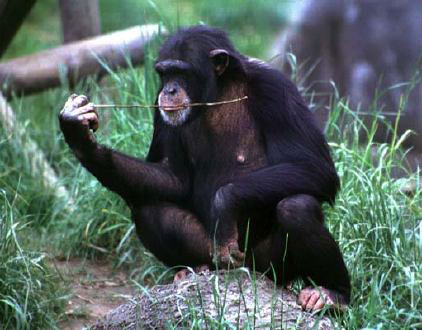
Chimpanzees are omnivorous creatures. Their diet consists primarily of fruits, seeds, stems, leaves, and nuts. They do however eat ants, termites, birds' eggs. An interesting fact about the Chimpanzees' eating habits when feeding on termites and ants is they have been observed fashioning tools to help with their feeding. They usually utilize sticks or stiff grass and weeds to dig out ants and termites from the hole that they live in. The use of the stick or stiff grass resembles the use of utensils by humans. Chimpanzees will also hunt larger prey depending on availability of other food. They have been known to kill and eat baboons, bush pigs, smaller monkeys, and small antelope.
The Chimpanzee has a similar anatomy to that of humans when comparing digestion and circulation. Food and water is digested and then transported by the circulatory system as nutrients, and wastes are eliminated after digestion. They have a closed circulatory system, making them able to transport the nutrients, oxygen, and water by blood cells, to where it is needed. Access nutrients is stored in the body as fat, but Chimpanzees are highly active creatures that need as much energy as they can get, so it is not likely for a Chimpanzee to be "fat." Also, like that of humans and other mammals, the Chimpanzee has a four-chambered heart, as well as arteries and veins, completely containing the blood within the blood vessels of its two-circuit circulatory system. | ©2007 Neil Madisen